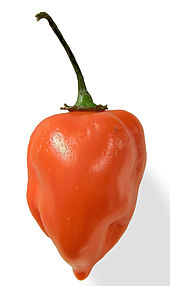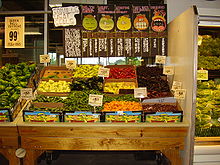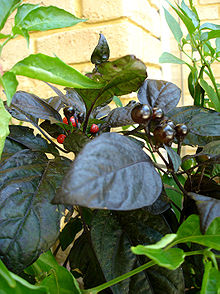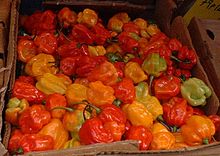- Chili pepper
-
For other uses, see Chili (disambiguation).
Chili pepper (also chile pepper or chilli pepper, from Nahuatl chilli) is the fruit[1] of plants from the genus Capsicum, members of the nightshade family, Solanaceae. The term in British English and in Australia, New Zealand, India,[2] Malaysia and other Asian countries is just chilli without pepper.
Chili peppers originated in the Americas. After the Columbian Exchange, many cultivars of chili pepper spread across the world, used in both food and medicine.
Contents
History
Chili peppers have been a part of the human diet in the Americas since at least 7500 BC. There is archaeological evidence at sites located in southwestern Ecuador that chili peppers were domesticated more than 6000 years ago,[3][4] and is one of the first cultivated crops in the Central and South Americas[5] that is self-pollinating.
Christopher Columbus was one of the first Europeans to encounter them (in the Caribbean), and called them "peppers" because they, like black and white pepper of the Piper genus known in Europe, have a spicy hot taste unlike other foodstuffs. Upon their introduction into Europe chilis were grown as botanical curiosities in the gardens of Spanish and Portuguese monasteries. But the monks experimented with the chilis' culinary potential and discovered that their pungency offered a substitute for black peppercorns, which at the time were so costly that they were used as legal currency in some countries.[6]
Chilies were cultivated around the globe after Columbus.[7][8] Diego Álvarez Chanca, a physician on Columbus' second voyage to the West Indies in 1493, brought the first chili peppers to Spain, and first wrote about their medicinal effects in 1494.
From Mexico, at the time the Spanish colony that controlled commerce with Asia, chili peppers spread rapidly into the Philippines and then to India, China, Indonesia, Korea and Japan. They were incorporated into the local cuisines.
An alternate account for the spread of chili peppers is that the Portuguese got the pepper from Spain, and cultivated it in India.[9] The chili pepper figures heavily in the cuisine of the Goan region of India, which was the site of a Portuguese colony (e.g., vindaloo, an Indian interpretation of a Portuguese dish). Chili peppers journeyed from India, through Central Asia and Turkey, to Hungary, where it became the national spice in the form of paprika.
Species and cultivars
The five domesticated species of chili peppers are:
- Capsicum annuum, which includes many common varieties such as bell peppers, wax, cayenne, jalapeños, and the chiltepin
- Capsicum frutescens, which includes malagueta, tabasco and Thai peppers, piri piri, African birdseye chili, Malawian Kambuzi
- Capsicum chinense, which includes the hottest peppers such as the naga, habanero, Datil and Scotch bonnet
- Capsicum pubescens, which includes the South American rocoto peppers
- Capsicum baccatum, which includes the South American aji peppers
Though there are only a few commonly used species, there are many cultivars and methods of preparing chili peppers that have different names for culinary use. Green and red bell peppers, for example, are the same cultivar of C. annuum, immature peppers being green. In the same species are the jalapeño, the poblano (which when dried is referred to as ancho), New Mexico (which is also known as chile colorado), Anaheim, serrano, and other cultivars.
Peppers are commonly broken down into three groupings: bell peppers, sweet peppers, and hot peppers. Most popular pepper varieties are seen as falling into one of these categories or as a cross between them.
Intensity
A display of hot peppers and a board explaining the Scoville scale at a Houston, Texas, grocery store
The substances that give chili peppers their intensity when ingested or applied topically are capsaicin (8-methyl-N-vanillyl-6-nonenamide) and several related chemicals, collectively called capsaicinoids.[10][11] Capsaicin is the primary ingredient in the pepper spray used as an irritant weapon.
When consumed, capsaicinoids bind with pain receptors in the mouth and throat that are responsible for sensing heat. Once activated by the capsaicinoids, these receptors send a message to the brain that the person has consumed something hot. The brain responds to the burning sensation by raising the heart rate, increasing perspiration and release of endorphins. A 2008 study[12] reports that capsaicin alters how the body's cells use energy produced by hydrolysis of ATP. In the normal hydrolysis the SERCA protein uses this energy to move calcium ions into the sarcoplasmic reticulum. When capsaicin is present, it alters the conformation of the SERCA, and thus reduces the ion movement; as a result the ATP energy (which would have been used to pump the ions) is instead released as heat.[13]
The "heat" of chili peppers was historically measured in Scoville heat units (SHU), which is a measure of how much a chili extract must be diluted in sugar syrup before its heat becomes undetectable to a panel of tasters.[14] Bell peppers rank at 0 SHU, New Mexico green chilis at about 1,500 SHU, jalapeños at 2,500–5,000 SHU, and habaneros at 300,000 SHU. The modern commonplace method for quantitative analysis of SHU rating uses high-performance liquid chromatography to directly measure the capsaicinoid content of a chili pepper variety. Pure capsaicin is a hydrophobic, colorless, odorless, and crystalline-to-waxy solid at room temperature, and measures 16,000,000 SHU.
World's hottest chili pepper
Current record holder
According to Guinness World Records, as of March 1, 2011, the world's hottest chili pepper is the Trinidad Scorpion Butch T pepper. [15] A laboratory test conducted in March, 2011 measured a specimen of Trinidad Scorpion Butch T at 1,463,700 Scoville heat units, making it hotter than the previous hottest chilli, the Naga Viper, at 1,382,118 SHU. The secret to the heat, according to the creators, is fertilizing the soil with the liquid runoff of a worm farm.[16]
History
- In 2007, Guinness World Records certified the bhut jolokia, also known as the ghost pepper/chili pepper, as being the world's hottest chili pepper at 401.5 times hotter than Tabasco sauce.[17]
- On December 3, 2010, the Bhut Jolokia was replaced as the hottest known chili pepper by the Naga Viper pepper, which had an average peak Scoville rating more than 300,000 points higher than an average bhut jolokia—but still not higher than the hottest ever recorded Dorset Naga.[18]
- In February 2011, Guinness World Records awarded the title of "World's Hottest Chilli" to the Infinity chilli grown in Grantham, England.[19] This chilli rates at 1,067,286 units on the Scoville scale.[20]
- On February 25, 2011, Guinness World Records announced that the Naga viper pepper had beaten the previous record holder by 314,832 (SHU) with a rating of 1,382,118.[15][21]
Currently, Scoville ratings are highly controversial among the pepper growing community and tests with more rigorous scientific standards are yet to be conducted on the many peppers vying for the title of the "world's hottest".
Uses
 Thai pepper. Similar in variety to the African birdseye, it exhibits considerable strength for its size.
Thai pepper. Similar in variety to the African birdseye, it exhibits considerable strength for its size.
Culinary uses
Chili pepper pods, which are berries, are used fresh or dried. Chiles are often dried to preserve them for long periods of time. Preserving may also be done by pickling fresh chilies.
Dried chilies are often ground to powders, although some Mexican dishes including variations on chiles rellenos may use whole reconstituted chilies, and others may reconstitute dried chilies before grinding to a paste. Chilies may be dried using smoke, such as the chipotle, which is the smoked, dried form of the jalapeño.
Many fresh chilies such as poblano have a tough outer skin which does not break down on cooking. For recipes where chiles are used whole or in large slices, roasting, or other means of blistering or charring the skin are usually performed so as not to entirely cook the flesh beneath. When cooled, the skins will usually slip off easily.
Chili pepper plant leaves, mildly bitter but nowhere near as hot as the fruits that come from the same plant, are cooked as greens in Filipino cuisine, where they are called dahon ng sili (literally "chili leaves"). They are used in the chicken soup, tinola.[22] In Korean cuisine, the leaves may be used in kimchi.[23] In Japanese cuisine, the leaves are cooked as greens, and also cooked in tsukudani style for preservation.
Chili is by far the most important fruit in Bhutan. Local markets are never without chili, always teemed with different colors and sizes, in fresh and dried form. Bhutanese call this crop ema (in Dzongkha) or solo (in Sharchop). Chili is a staple fruit in Bhutan; the ema datsi recipe is entirely made of chili mixed with local cheese. Chili is also an important ingredient in almost all curries and food recipes in the country.
Chilies are present in many cuisines. Some notable dishes other than the ones mentioned elsewhere in this article include:
- Paprikash from Hungary: uses significant amounts of mild, ground, dried chilies, aka paprika, in a braised chicken dish
- Paprykarz szczeciński is a Polish fish paste with rice, onion, tomato concentrate, vegetable oil, chilli pepper powder and other spices.
- Chiles en nogada from the Puebla region of Mexico: uses fresh mild chilies stuffed with meat and covered with a creamy nut-thickened sauce
- Mole poblano from the city of Puebla in Mexico: uses several varieties of dried chilies, nuts, spices, and fruits to produce a thick, dark sauce for poultry or other meats
- Puttanesca sauce from Italy: a tomato-based sauce for pasta including dried hot chilies
- Kung Pao Chicken (also spelled Gong Bao) from the Sichuan region of China: small hot dried chiles are briefly fried in oil to add spice to the oil then used for frying.
- Nigerian dishes and those in many parts of Africa.
Fresh or dried chilies are often used to make hot sauce, a bottled condiment to add spice to other dishes. Hot sauces are found in many cuisines including harissa from the Middle East, chili oil from China (known as rāyu in Japan), and sriracha from Thailand.
Psychology
Psychologist Paul Rozin suggests that eating chilis is an example of a "constrained risk" like riding a roller coaster, in which extreme sensations like pain and fear can be enjoyed because individuals know that these sensations are not actually harmful. This method lets people experience extreme feelings without any risk of bodily harm.[24]
Eating chili is viewed as a warrior’s ritual in Japan because of its spicyness that gives individual fear and mental block. By forcing themselves to eat chili, warriors’ mental state gets stronger and may even feel invincible when stepping onto the battlefield. Eating chili has been a popular practice among the karate athletes who use it to strengthen their minds and determination.
Medicinal
Capsaicin is a safe and effective topical analgesic agent in the management of arthritis pain, herpes zoster-related pain, diabetic neuropathy, postmastectomy pain, and headaches.[25]
Irritant weapon
Capsaicin extracted from chilis is used in a spray as a non-lethal weapon.
Crop defense
Farmers in Africa and South Asia have found the use of chilis effective in crop defense against elephants. The chilis are spread on fences and other structures to keep the elephants away.[citation needed] Because the elephants have a large and sensitive olfactory and nasal system the smell of the chilli causes them discomfort and deters them from feeding on the crops. This can lessen dangerous physical confrontation between people and elephants.
Food defense
As birds have a lessened sensitivity to the effects of chili it can be used to keep mammalian vermin from bird seed (see Evolutionary Advantages below).
Nutritional value
Peppers, hot chili, red, raw Nutritional value per 100 g (3.5 oz) Energy 166 kJ (40 kcal) Carbohydrates 8.8 g - Sugars 5.3 g - Dietary fiber 1.5 g Fat 0.4 g Protein 1.9 g Water 88 g Vitamin A equiv. 48 μg (6%) - beta-carotene 534 μg (5%) Vitamin B6 0.51 mg (39%) Vitamin C 144 mg (173%) Iron 1 mg (8%) Magnesium 23 mg (6%) Potassium 322 mg (7%) Percentages are relative to US recommendations for adults.
Source: USDA Nutrient DatabaseRed chilies contain high amounts of vitamin C and carotene (provitamin A). Yellow and especially green chilies (which are essentially unripe fruit) contain a considerably lower amount of both substances. In addition, peppers are a good source of most B vitamins, and vitamin B6 in particular. They are very high in potassium, magnesium, and iron. Their high vitamin C content can also substantially increase the uptake of non-heme iron from other ingredients in a meal, such as beans and grains.
Evolutionary advantages
Birds do not have the same sensitivity to capsaicin, because it targets a specific pain receptor in mammals. Chili peppers are eaten by birds living in the chili peppers' natural range. The seeds of the peppers are distributed by the birds that drop the seeds while eating the pods, and the seeds pass through the digestive tract unharmed. This relationship may have promoted the evolution of the protective capsaicin.[26] Products based on this substance have been sold to treat the seeds in bird feeders to deter squirrels and other mammalian vermin without also deterring birds. Capsaicin is also a defense mechanism against microbial fungi that invade through punctures made in the outer skin by various insects.[27]
Spelling and usage
The three primary spellings are chili, chile and chilli, all of which are recognized by dictionaries.
- Chili is widely used. However, this spelling is discouraged by some since it also commonly used as a short name for chili con carne (literally chili with meat). Most versions are seasoned with chili powder, which can refer to pure dried, ground chili peppers, or to a mixture containing other spices.
- Chile is an alternate usage, the most common Spanish spelling in Mexico,[28] as well as some parts of the United States and Canada, which refers specifically to this plant and its fruit. In the American Southwest (particularly northern New Mexico), chile also denotes a thick, spicy, un-vinegared sauce which is available in red and green varieties, and which is often served over most New Mexican food.
- Chilli was the original Romanization of the Náhuatl language word for the fruit (chīlli)[29] and is the preferred British spelling according to the Oxford English Dictionary, although it also lists chile and chili as variants.
The name of the plant bears no relation to Chile, the country, which is named after the Quechua chin ("cold"), tchili ("snow"), or chilli ("where the land ends"). Chile, Panama, Peru and Puerto Rico are some of the Spanish-speaking countries where chilis are known as ají, a word of Taíno origin.
There is also some disagreement on the use of the word pepper for chilis because pepper originally referred to the genus Piper, not Capsicum; however this usage is included in English dictionaries, including the Oxford English Dictionary (sense 2b of pepper) and Merriam-Webster.[30] The word pepper is commonly used in the botanical and culinary fields in the names of different types of chili peppers.
See also
- Capsaicin, the heat simulating chemical in Chili pepper
- Chili grenade, a type of weapon made with chili peppers
- History of chocolate, which the Mayans drank with ground chili peppers
- Ristra, an arrangement of dried chili pepper pods
- Taboo food and drink, which in some cultures includes chili peppers
References
- ^ "HORT410. Peppers - Notes". Purdue University Department of Horticulture and Landscape Architecture. http://www.hort.purdue.edu/rhodcv/hort410/pepper/pe00001.htm. Retrieved 20 October 2009. "Common name: pepper. Latin name: Capsicum annuum L. ... Harvested organ: fruit. Fruit varies substantially in shape, pericarp thickness, color and pungency."
- ^ http://economictimes.indiatimes.com/features/et-sunday-magazine/indian-chilli-displacing-jalapenos-in-global-cuisine/articleshow/8190311.cms
- ^ Perry, L. et al. 2007. Starch fossils and the domestication and dispersal of chili peppers (Capsicum spp. L.) in the Americas. Science 315: 986–988. Link.
- ^ BBC News Online. 2007. Chilies heated ancient cuisine. Friday, 16 February. Available from: http://news.bbc.co.uk/2/hi/americas/6367299.stm. Retrieved 16 February 2007.
- ^ "Bosland, P.W. 1996. Capsicums: Innovative uses of an ancient crop. ''p. 479–487. In: J. Janick (ed.), Progress in new crops. ASHS Press, Arlington, VA.''". Hort.purdue.edu. 1997-08-22. http://www.hort.purdue.edu/newcrop/proceedings1996/V3-479.html. Retrieved 2010-12-23.
- ^ TheNibble Online Specialty Food Magazine. Chile Pepper Glossary. August 2008. Available from: http://www.thenibble.com/reviews/main/salts/scoville.asp. Retrieved 31 August 2010.
- ^ Heiser Jr., C.B. 1976. Pp. 265–268 in N.W. Simmonds (ed.). Evolution of Crop Plants. London: Longman.
- ^ Eshbaugh, W.H. 1993. Pp. 132-139 in J. Janick and J.E. Simon (eds.). New Crops. New York: Wiley.
- ^ Collingham, Elizabeth (February 2006). Curry. Oxford University Press. ISBN 0-09-943786-4.
- ^ S Kosuge, Y Inagaki, H Okumura (1961). Studies on the pungent principles of red pepper. Part VIII. On the chemical constitutions of the pungent principles. Nippon Nogei Kagaku Kaishi (J. Agric. Chem. Soc.), 35, 923–927; (en) Chem. Abstr. 1964, 60, 9827g.
- ^ (ja) S Kosuge, Y Inagaki (1962) Studies on the pungent principles of red pepper. Part XI. Determination and contents of the two pungent
- ^ Yasser A. Mahmmoud (2008). "Capsaicin Stimulates Uncoupled ATP Hydrolysis by the Sarcoplasmic Reticulum Calcium Pump". Journal of Biological Chemistry 283 (31): 21418–21426. doi:10.1074/jbc.M803654200. PMID 18539598. http://www.jbc.org/content/283/31/21418.abstract.
- ^ Hot News about Chili Peppers, Chemical & Engineering News, 86, 33, 18 Aug. 2008, p. 35
- ^ "History of the Scoville Scale | FAQS". Tabasco.Com. http://www.tabasco.com/info_booth/faq/scoville_how.cfm. Retrieved 2010-12-23.
- ^ a b "Hottest Chilli". Guinness World Records. http://www.guinnessworldrecords.com/Search/Details/Hottest-chili/49118.htm. Retrieved February 26, 2011.
- ^ "Aussies grow world's hottest chilli" Retrieved April 12, 2011
- ^ "New World Champ - The World's Hottest Chile Pepper.". http://ushotstuff.com/worldshottestchile.htm. Retrieved 2010-09-29.
- ^ Dykes, B.M. (2010). World’s hottest pepper is ‘hot enough to strip paint’. Yahoo News, December 3, 2010.
- ^ "Hottest Chilli". Guinness World Records. http://www.guinnessworldrecords.com/Search/Details/Hottest-chili/49118.htm. Retrieved February 20, 2011.
- ^ "Infinity Chilli – New Guinness World Record Holder". The Chilli Foundry. February 15, 2011. http://www.chilefoundry.co.uk/2011/02/15/infinity-chilli-guinness-world-records/. Retrieved February 20, 2011.
- ^ "Title of world's hottest chili pepper stolen - again". The Independent. February 25, 2011. http://www.independent.co.uk/life-style/food-and-drink/title-of-worlds-hottest-chili-pepper-stolen--again-2225925.html. Retrieved February 27, 2011.
- ^ http://www.tribo.org/vegetables/dahongsili.html
- ^ http://sfood.info/cuisine/kimchi/k35.htm[dead link]
- ^ Paul Rozin1 and Deborah Schiller, Paul; Schiller, Deborah (1980). "The nature and acquisition of a preference for chili pepper by humans". Motivation and Emotion 4 (1): 77–101. doi:10.1007/BF00995932.
- ^ Cancer nursing: principles and practice - Google Books. Books.google.ca. 2005. ISBN 9780763747206. http://books.google.ca/books?id=HXsl_PhXG0kC&pg=PA682&dq=capsaicin+cancer+oncologist. Retrieved 2010-12-23.
- ^ Tewksbury, J. J.; Nabhan, G. P. (2001). "Directed deterrence by capsaicin in chilies". Nature 412 (6845): 403–404. doi:10.1038/35086653. PMID 11473305.
- ^ John Roach (11 August 2008). "Fungus Puts the Heat in Chili Peppers, Study Says". Discover Magazine. http://news.nationalgeographic.com/news/2008/08/080811-chili-bugs.html. Retrieved 2008-08-13.
- ^ Heiser, Charles (August 1990). Seed To Civlization: The Story of Food. Cambridge: Harvard University Press. ISBN 0-67-479681-0.
- ^ "A Brief History of Chilies : Kakawa Chocolate House, Mesoamerican Mayan Aztec Drinking Chocolate, Historic European and Colonial American Drinking Chocolate, Truffles and More". Kakawachocolates.com. http://www.kakawachocolates.com/index.php?main_page=page_4. Retrieved 2010-12-23.
- ^ "va=pepper - Definition from the Merriam-Webster Online Dictionary". M-w.com. 2010-08-13. http://www.m-w.com/cgi-bin/dictionary?book=Dictionary&va=pepper. Retrieved 2010-12-23.
External links
- Plant Cultures: Chilli pepper botany, history and uses
- The Chile Pepper Institute of New Mexico State University
- Capsicums: Innovative Uses of an Ancient Crop
- Chilibase.info - Chilli pepper database and indentification
- Chile varieties database
Categories:- Agriculture in Mesoamerica
- Chili peppers
- Medicinal plants
- Crops originating from Ecuador
- Crops originating from Mexico
- Crops originating from Peru
- Symbols of New Mexico
- Leaf vegetables
- New Mexican cuisine
- Cuisine of the Southwestern United States
- Cuisine of the Western United States
- Crops originating from the Americas
Wikimedia Foundation. 2010.








